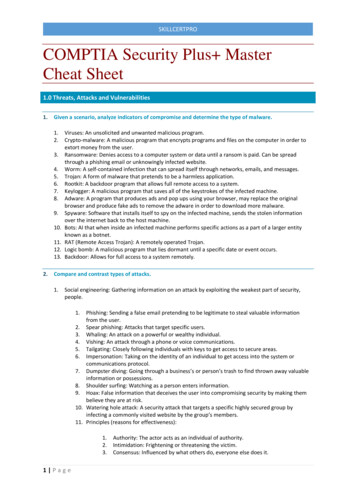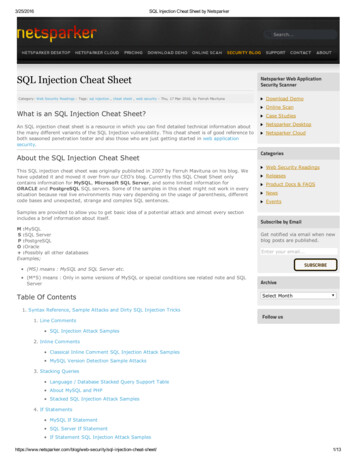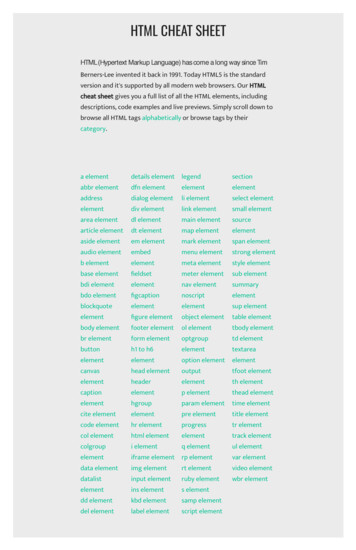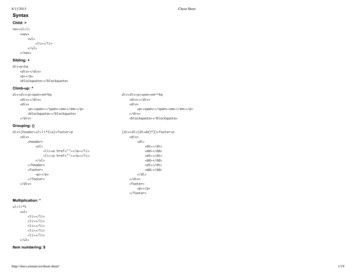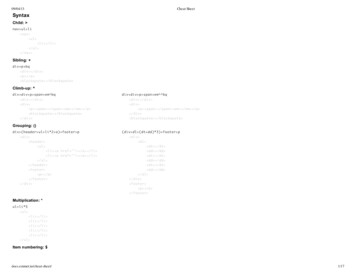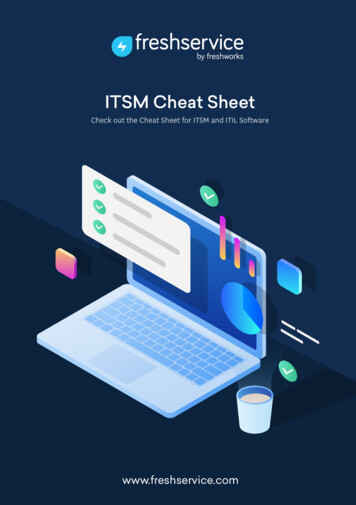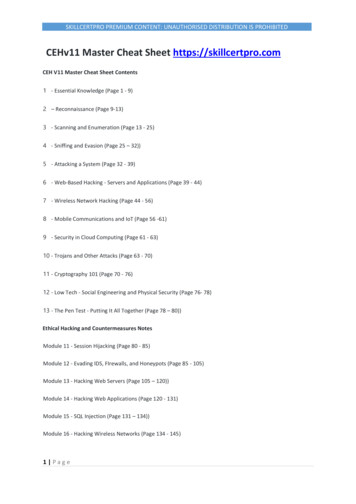
Transcription
SKILLCERTPRO PREMIUM CONTENT: UNAUTHORISED DISTRIBUTION IS PROHIBITEDCEHv11 Master Cheat Sheet https://skillcertpro.comCEH V11 Master Cheat Sheet Contents1 - Essential Knowledge (Page 1 - 9)2 – Reconnaissance (Page 9-13)3 - Scanning and Enumeration (Page 13 - 25)4 - Sniffing and Evasion (Page 25 – 32))5 - Attacking a System (Page 32 - 39)6 - Web-Based Hacking - Servers and Applications (Page 39 - 44)7 - Wireless Network Hacking (Page 44 - 56)8 - Mobile Communications and IoT (Page 56 -61)9 - Security in Cloud Computing (Page 61 - 63)10 - Trojans and Other Attacks (Page 63 - 70)11 - Cryptography 101 (Page 70 - 76)12 - Low Tech - Social Engineering and Physical Security (Page 76- 78)13 - The Pen Test - Putting It All Together (Page 78 – 80))Ethical Hacking and Countermeasures NotesModule 11 - Session Hijacking (Page 80 - 85)Module 12 - Evading IDS, FIrewalls, and Honeypots (Page 85 - 105)Module 13 - Hacking Web Servers (Page 105 – 120))Module 14 - Hacking Web Applications (Page 120 - 131)Module 15 - SQL Injection (Page 131 – 134))Module 16 - Hacking Wireless Networks (Page 134 - 145)1 Page
SKILLCERTPRO PREMIUM CONTENT: UNAUTHORISED DISTRIBUTION IS PROHIBITEDModule 17 - Hacking Mobile Platforms (Page 145 -146)CEHv11 Tool ListTool List (Page 146 - 152)Essential KnowledgeThe OSI Reference ModelLayerDescriptionTechnologiesData Unit1PhysicalUSB, BluetoothBit2Data LinkARP, onX255, SCPDataAFP, MIMEData6Presentation7ApplicationTCP/IP Model2 PageFTP, HTTP, SMTPData
SKILLCERTPRO PREMIUM CONTENT: UNAUTHORISED DISTRIBUTION IS PROHIBITEDLayer1DescriptionNetwork AccessOSI Layer Equivalent1, 22Internet33Transport44Application5-7TCP HandshakeSYN - SYN-ACK - ACKARP Resolves IP address to physical addressNetwork Security Zones Internet - uncontrollable Internet DMZ - controlled buffer network Production Network Zone - very restricted; controls direct access from uncontrolled zones; has nousers Intranet Zone - controlled; has little to no heavy restrictions Management Network Zone - might find VLANs and IPSEC; highly secured; strict policiesVulnerabilities Common Vulnerability Scoring System (CVSS) - places numerical score based on severity National Vulnerability Database (NVD) - US government repository of vulnerabilitiesVulnerability Categories Misconfiguration - improperly configuring a service or application Default installation - failure to change settings in an application that come by default3 Page
SKILLCERTPRO PREMIUM CONTENT: UNAUTHORISED DISTRIBUTION IS PROHIBITED Buffer overflow - code execution flaw Missing patches - systems that have not been patched Design flaws - flaws inherent to system design such as encryption and data validation Operating System Flaws - flaws specific to each OS Default passwords - leaving default passwords that come with system/applicationVulnerability Management Tools Nessus Qualys GFI Languard Nikto OpenVAS Retina CSTerms to Know Hack value - perceived value or worth of a target as seen by the attacker Zero-day attack - attack that occurs before a vendor knows or is able to patch a flawDoxing - searching for and publishing information about an individual usually with a malicious intent Enterprise Information Security Architecture (EISA) - process that determines how systems workwithin an organization Incident management - deals with specific incidents to mitigate the attackThreat Modeling Identify security objectives Application Overview Decompose application Identify threats Identify vulnerabilitiesRisk Management Risk identification Risk assessment Risk treatment4 Page
SKILLCERTPRO PREMIUM CONTENT: UNAUTHORISED DISTRIBUTION IS PROHIBITED Risk tracking Risk review*Uses risk analysis matrix to determine threat levelTypes of Security ControlsDescriptionExamplesPhysicalGuards, lights, camerasTechnicalEncryption, smart cards, access control listsAdministrativeTraining awareness, ion, alarm bellsDetectiveaudits, backupsDescriptionCorrectiveExamplesrestore operationsBusiness Analysis Business Impact Analysis (BIA) o Maximum Tolerable Downtime (MTD) Business Continuity Plan (BCP) o Disaster Recovery Plan (DRP) Annualized Loss Expectancy (ALE) oExpectancy (SLE) ALE SLE * ARO Annual Rate of Occurrence (ARO) oUser Behavior Analysis (UBA) - tracking users and extrapolating data in light of malicious activityCIA Triad Confidentiality - passwords, encryption5 PageSingle Loss
SKILLCERTPRO PREMIUM CONTENT: UNAUTHORISED DISTRIBUTION IS PROHIBITED Integrity - hashing, digital signatures Availability - anti-dos solutionsBit flipping is an example of an integrity attack. The outcome is not to gain information - it is to obscure thedata from the actual user.Confidentiality ! authentication - MAC address spoofing is an authentication attackCommon Criterial for Information Technology Security Evaluation Routinely called "Common Criteria" (CC) Evaluation Assurance Level (EAL) - goes from level 1 - 7 Target of Evaluation - the system that is being tested Security Target (ST) - document describing the TOE and security requirements Protection Profile (PP) - security requirements that are specific to the type of device being testedAccess Control Types Mandatory (MAC) - access is set by an administrator Discretionary (DAC) - allows users to give access to resources that they own and controlSecurity Policies Access Control - what resources are protected and who can access them Information Security - what can systems be used for Information Protection - defines data sensitivity levels Password - all things about passwords (how long, characters required, etc.) E-Mail - proper and allowable use of email systems Information Audit - defines the framework used for auditingPolicy Categorizations Promiscuous - wide open Permissive - blocks only known dangerous things Prudent - blocks most and only allows things for business purposes Paranoid - locks everything downStandards - mandatory rules to achieve consistencyBaselines - provide the minimum security necessaryGuidelines - flexible or recommended actions6 Page
SKILLCERTPRO PREMIUM CONTENT: UNAUTHORISED DISTRIBUTION IS PROHIBITEDProcedures - step by step instructionsScript Kiddie - uneducated in security methods, but uses tools that are freely available to perform maliciousactivitiesPhreaker - manipulates telephone systemsThe Hats White Hat - ethical hackers Black Hat - hackers that seek to perform malicious activities Gray Hat - hackers that perform good or bad activities but do not have the permission of theorganization they are hacking againstHacktivist - someone who hacks for a causeSuicide Hackers - do not case about any impunity to themselves; hack to get the job doneCyberterrorist - motivated by religious or political beliefs to create fear or disruptionState-Sponsored Hacker - hacker that is hired by a governmentAttack Types Operating System (OS) - attacks targeting OS flaws or security issues inside such as guest accounts ordefault passwords7 Page
SKILLCERTPRO PREMIUM CONTENT: UNAUTHORISED DISTRIBUTION IS PROHIBITEDApplication Level - attacks on programming code and software logic Shrink-Wrap Code - attack takes advantage of built-in code or scripts Misconfiguration - attack takes advantage of systems that are misconfigured due to improperconfiguration or default configurationInfowar - the use of offensive and defensive techniques to create an advantageHacking Phases1.Reconnaissance - gathering evidence about targets2.Scanning & Enumeration - obtaining more in-depth information about targets3.Gaining Access - attacks are leveled in order to gain access to a system4.Maintaining Access - items put in place to ensure future access5.Covering Tracks - steps taken to conceal success and intrusionTypes of Reconnaissance Passive - gathering information about the target without their knowledge Active - uses tools and techniques that may or may not be discoveredSecurity Incident and Event Management (SIEM) Functions related to a security operations center (SOC) o Identifying o Monitoring o Recording oAuditing o AnalyzingEthical hacker - employs tools that hackers use with a customer's permission; always obtains an agreementfrom the client with specific objectives before any testing is doneCracker - uses tools for personal gain or destructive purposesPenetration Test Clearly defined, full scale test of security controls Phases o Preparation - contracts and team determined o Assessment - all hacking phases(reconnaissance, scanning, attacks, etc.) o Post-Assessment - reports & conclusions Types o Black Box - done without any knowledge of the system or network o White Box - completeknowledge of the system o Grey Box - has some knowledge of the system and/or networkLaw Categories Criminal - laws that protect public safety and usually have jail time attached Civil - private rights and remedies8 Page
SKILLCERTPRO PREMIUM CONTENT: UNAUTHORISED DISTRIBUTION IS PROHIBITED Common - laws that are based on societal customsLaws and Standards OSSTM Compliance - "Open Source Security Testing Methodology Manual" maintained byISECOM , defines three types of complianceo Legislative - Deals with goverment regulations (Such as SOX and HIPAA) oContractual- Deals with industry / group requirement (Such as PCI DSS) oStandards based - Deals withpractices that must be followed by members of a given group/organization (Such as ITIL ,ISO andOSSTMM itself) OSSTM Controls oOSSTM Class A - Interactive Controls Authentication - Provides for identification and authorization based on credentials Indemnification - Provided contractual protection against loss or damages Subjugation - Ensures that interactions occur according to processes defined by theasset owner Continuity - Maintains interactivity with assets if corruption of failure ccours Resilience - Protects assets from corruption and failure oProcess Controls Non-repudiation - Prevents participants from denying its actions Confidentiality - Ensures that only participants know of an asset Privacy - Ensures that only participants have access to the asset Integrity - Ensures that only participants know when assets and processes change Alarm - Notifies participants when interactions occurOSSTM Class B - ISO 27001 - Security standard based on the British BS7799 standard, focuses on secuirty governance NIST-800-53 - Catalogs security and privacy controls for federal information systems, created to helpimplementation of FISMA ISO 27002 AND 17799 - Based on BS799 but focuses on security objectives and provides securitycontrols based on industry best pratice FISMA - "Federal Information Security Modernization Ac Of 2002" A law updated in 2004 to codifythe authority of the Department of Homeland Security with regard to implementation of informationsecurity policiesFITARA - "Federal Information Technology Acquisition Reform Act" A 2013 bill that was intended tochange the framework that determines how the US GOV purchases technology HIPAA - "Health Insurance Portability and Accountability Act" a law that set's privacy standards to protect patient medical records and health information shared between doctors, hospitals and insuranceproviders9 Page
SKILLCERTPRO PREMIUM CONTENT: UNAUTHORISED DISTRIBUTION IS PROHIBITED PCI-DSS - "Payment Card Industry Data Security Standard" Standard for organizations handling CreditCards, ATM cards and other POS cards COBIT - "Control Object for Information and Related Technology" IT Governance framework andtoolset , created by ISACA and ITGI SOX - "Sarbanes-Oxley Act" Law that requires publicly traded companies to submit to independentaudits and to properly disclose finical information GLBA - "U.S Gramm-Leach-Bliley Act" Law that protects the confidentiality and integrity of personalinformation that is collected by financial institutions. CSIRT - "Computer Security Incident Response Team" CSIRT provided a single point of contact whenreporting computer security incidents ITIL - "Information Technology Infrastructure Library" - An operational framework developed in the'80s that standardizes IT management proceduresControls Directive - Also known as procedural controls because they deal with company procedures such assecurity policies, operations plans, and guidelines. Deterrent - Controls that are used to dissuade potential attackers, such as signs that warn possibleattackers about the alarm system and monitoring in place. Preventive - Controls used to stop potential attacks by preventing users from performing specificactions, such as encryption and authentication Compensating - Controls used to supplement directive controls, such as administrator reviewing logsfiles for violations of company policy Detective - Controls used to monitor and alert on malicious or unauthorized activity , such as IDS'sand CCTV feeds monitored in real life Corrective - Controls used to repair damage caused by malicious events. Such as AntiVirus softwareand IPS (IPS being both a detective and corrective control) RecoveryReconnaissanceFootprinting Looking for high-level information on a target Types10 P a g e
SKILLCERTPRO PREMIUM CONTENT: UNAUTHORISED DISTRIBUTION IS PROHIBITEDoAnonymous - information gathering without revealing anything about yourselfoPseudonymous - making someone else take the blame for your actionsFour Main Focuses Know the security posture Reduce the focus area Identify vulnerabilities Draw a network mapTypes of Footprinting Active - requires attacker to touch the device or network oSocialengineering and other communication that requires interaction with target Passive - measures to collect information from publicly available sources oWebsites, DNS records, business information databasesCompetitive Intelligence - information gathered by businesses about competitorsAlexa.com - resource for statistics about websitesMethods and ToolsSearch Engines NetCraft - information about website and possibly OS info Job Search Sites - information about technologies can be gleaned from job postings Googleofiletype: - looks for file types o index of - directorylistings oinfo: - contains Google's information about thepage ointitle: - string in title o inurl: - string in url olink: - finds linked pages opages o related: - finds similarsite: - finds pages specific to that siteMetagoofil - uses Google hacks to find information in meta tagsWebsite Footprinting11 P a g e
SKILLCERTPRO PREMIUM CONTENT: UNAUTHORISED DISTRIBUTION IS PROHIBITEDWeb mirroring - allows for discrete testing offline oHTTrack o Black Widow o Wget o WebRipper oTeleport Pro o Backstreet Browser Archive.org - provides cached websites from various dates which possibly have sensitiveinformation that has been now removedEmail Footprinting Email header - may show servers and where the location of those servers are Email tracking - services can track various bits of information including the IP address ofwhere it was opened, where it went, etc.DNS Footprinting PortsoName lookup - UDP 53 oZone transfer - TCP 53 Zone transfer replicates all records Name resolvers answer requests Authoritative Servers hold all records for a namespace DNS Record Types oName12 P a g eDescriptionPurposeSRVServicePoints to a specific serviceSOAStart ofAuthorityIndicates the authoritative NS for anamespacePTRPointerMaps an IP to a hostnameNSNameserverLists the nameservers for a namespace
SKILLCERTPRO PREMIUM CONTENT: UNAUTHORISED DISTRIBUTION IS PROHIBITEDNameDescriptionPurposeMXMail ExchangeLists email serversCNAMECanonical NameMaps a name to an A reccordAAddressMaps an hostname to an IP address DNS Poisoning - changes cache on a machine to redirect requests to a maliciousserver DNSSEC - helps prevent DNS poisoning by encrypting records SOA Record FieldsoSource Host - hostname of the primaryDNS oContact Email - email for theperson responsible for the zone file oSerial Number - revision number thatincrements with each change oRefresh Time - time in which an updateshould occur oRetry Time - time thata NS should wait on a failure oExpireTime - time in which a zone transfer isallowed to complete oTTL - minimumTTL for records within the zone IP Address ManagementoARIN - North America o APNIC - AsiaPacific oRIPE - Europe, Middle East oLACNIC - Latin America oAfriNIC- Africa Whois - obtains registration information for the domain13 P a g e
SKILLCERTPRO PREMIUM CONTENT: UNAUTHORISED DISTRIBUTION IS PROHIBITED Nslookup - performs DNS queriesonslookup [ - options ] [ hostname ] ointeractive zone transfer nslookup server set type any ls -d domainname.comDig - unix-based command like nslookup o dig@server name typeNetwork Footprinting IP address range can be obtained from regional registrar (ARIN here) Use traceroute to find intermediary servers o Windows command - tracert Linux Command - traceroutetraceroute uses ICMP echo in WindowsOther Tools OSRFramework - uses open source intelligence to get information about targetWeb Spiders - obtain information from the website such as pages, etc. Social Engineering Tools o Shodan - search engine that shows devices connected to the InternetMaltego oSocial Engineering Framework (SEF)Computer Security Incident Response Team (CSIRT) - point of contact for all incidentresponse services for associates of the DHSScanning and EnumerationScanning - discovering systems on the network and looking at what ports are open as wellas applications that may be runningConnectionless Communication - UDP packets are sent without creating a connection.Examples are TFTP, DNS (lookups only) and DHCP14 P a g e
SKILLCERTPRO PREMIUM CONTENT: UNAUTHORISED DISTRIBUTION IS PROHIBITEDConnection-Oriented Communication - TCP packets require a connection due to the size ofthe data being transmitted and to ensure deliverabilityTCP FlagsFlagNameSYNSynchronizeFlagNameFunctionSet during initial communication. Negotiating of parameters andsequence numbersFunctionACKAcknowledgmentSet as an acknowledgement to the SYN flag. Always set afterinitial SYNRSTResetFINFinishOrdered close to communicationsPSHPushForces the delivery of data without concern for bufferingURGUrgentData inside is being sent out of band. Example is cancelling amessageForces the termination of a connection (in both directions)TCP Handshake SYN - SYN-ACK - ACK Sequence numbers increase on new communication. Example is computers A and B. Awould increment B's sequence number. A would never increment it's own sequence.15 P a g e
SKILLCERTPRO PREMIUM CONTENT: UNAUTHORISED DISTRIBUTION IS PROHIBITEDPort Numbers Internet Assigned Numbers Authority(IANA) - maintains Service Name andTransport Protocol Port Number Registrywhich lists all port number reservations Ranges o Well-known ports - 0 - 1023 oRegistered ports - 1024 - 49,151 o Dynamicports - 49,152 - 65,53516 P a g ePort NumberProtocolTransport Protocol20/21FTPTCP
SKILLCERTPRO PREMIUM CONTENT: UNAUTHORISED DISTRIBUTION IS PROHIBITED17 P a g ePort NumberProtocolTransport UDP443HTTPSTCP
SKILLCERTPRO PREMIUM CONTENT: UNAUTHORISED DISTRIBUTION IS PROHIBITEDoo445SMBTCP514SYSLOGUDPA service is said to be listening for a port when it hasthat specific port openOnce a service has made a connection, the port is in anestablished state o Netstat Shows open ports on computer netstat -an displays connections in numerical form netstat -b displays executables tied to the open port (admin only)Subnetting IPv4 Main Address Types orecipient oUnicast - acted on by a singleMulticast - acted on by members of a specificgroup o Broadcast - acted on by everyone on the network Limited - delivered to every system in the domain (255.255.255.255) Directed - delivered to all devices on a subnet and use that broadcastaddressSubnet mask - determines how many address available on aspecific subnet oRepresented by three methods Decimal - 255.240.0.0 Binary - 11111111.11110000.00000000.00000000 CIDR - x.x.x.x/12 (where x.x.x.x is an ip address on that range) o If all thebits in the host field are 1s, the address is the broadcast oall 0s, it's the network address oIf they areAny other combination indicates anaddress in the range oScanning Methodology Check for live systems - ping or other type of way to determine live hosts Check for open ports - once you know live host IPs, scan them for listening ports Scanbeyond IDS - if needed, use methods to scan beyond the detection systems Perform banner grabbing - grab from servers as well as perform OS fingerprinting18 P a g e
SKILLCERTPRO PREMIUM CONTENT: UNAUTHORISED DISTRIBUTION IS PROHIBITED Scan for vulnerabilities - use tools to look at the vulnerabilities of open systems Draw network diagrams - shows logical and physical pathways into networks Prepare proxies - obscures efforts to keep you hiddenIdentifying Targets The easiest way to scan for live systems is through ICMP.It has it's shortcomings and is sometimes blocked on hosts that are actually live. Message Types and ReturnsICMP Message TypeDescription and Codes0: Echo ReplyAnswer to a Type 8 Echo Request3: DestinationUnreachableError message followed by these codes:0 - Destination network unreachable1 - Destination host unreachable6 - Network unknown7 - Host unknown9 - Network administratively prohibited10 - Host administratively prohibited13 - Communication administratively prohibited4: Source QuenchA congestion control message5: RedirectSent when there are two or more gateways available for thesender to use. Followed by these codes:0 - Redirect datagram for the network1 - Redirect datagram for the host8: Echo RequestA ping message, requesting an echo reply11: Time ExceededPacket took too long to be routed (code 0 is TTL expired)o19 P a g ePayload of an ICMP message can be anything; RFC never set what it was supposed tobe. Allows for covert channels
SKILLCERTPRO PREMIUM CONTENT: UNAUTHORISED DISTRIBUTION IS PROHIBITEDoPing sweep - easiest method to identify hostsoICMP Echo scanning - sending an ICMP Echo Request to the network IP addressoAn ICMP return of type 3 with a code of 13 indicates a poorly configured firewalloPing scanning tools Nmap Angry IP Scanner Solar-Winds Engineer Toolkit Advanced IP ScannerPinkie oNmap virtually always does a ping sweep with scansunless you turn it offPort Scan Types Full connect - TCP connect or full open scan - full connection and then tears down with RSToEasiest to detect, but most reliable onmap -sT Stealth - half-open scan or SYN scan - only SYN packets sent. Responses same as full.oUseful for hiding efforts and evading firewalls onmap -sS Inverse TCP flag - uses FIN, URG or PSH flag. Open gives no response. Closed givesRST/ACK oscan) onmap -sN (Nullnmap -sF (FINscan) Xmas - so named because all flags are turned on so it's "lit up" like a Christmas tree oResponses are same as Inverse TCP scan oDo not work against Windows machines onmap -sX ACK flag probe - multiple methods o TTL version - if TTL of RST packet 64, port is open oWindow version - if the Window on the RST packet is anything other than 0, port open oCan be used to check filtering. If ACK is sent and noresponse, stateful firewall present.onmap -sA (ACK scan) o nmap -sW (Window scan)IDLE Scan - uses a third party to check if a port is open o Looks at the IPID to see if there isa repsonse o Only works if third party isn't transmitting data oSends a requestto the third party to check IPID id; then sends a spoofed packet to the target with a returnof the third party; sends a request to the third party again to check if IPID increased.20 P a g e IPID increase of 1 indicates port closed IPID increase of 2 indicates port open
SKILLCERTPRO PREMIUM CONTENT: UNAUTHORISED DISTRIBUTION IS PROHIBITED idle oIPID increase of anything greater indicates the third party was notnmap -sINmap SwitchesSwitchDescription-sAACK scan-sFFIN scan-sIIDLE scan-sLDNS scan (list scan)-sNNULL scan-sOProtocol scan (tests which IP protocols respond)-sPPing scan-sRRPC scan-sSSYN scan-sTTCP connect scan-sWWindow scan21 P a g e
SKILLCERTPRO PREMIUM CONTENT: UNAUTHORISED DISTRIBUTION IS PROHIBITED-sXXMAS scan-AOS detection, version detection, script scanning and traceroute-PIICMP ping-PoNo ping-PSSYN ping-PTTCP pingSwitchDescription-oNNormal output-oXXML output-T0 through -T2Serial scans. T0 is slowest-T3 through -T5Parallel scans. T3 is slowest Nmap runs by default at a T3 level Fingerprinting - another word for port sweeping and enumerationHping Another powerful ping sweep and port scanning tool Also can craft packets hping3 -1 IPaddress22 P a g e
SKILLCERTPRO PREMIUM CONTENT: UNAUTHORISED DISTRIBUTION IS PROHIBITEDSwitchDescription-1Sets ICMP mode-2Sets UDP mode-8Sets scan mode. Expects port range without -p flag-9Listen mode. Expects signature (e.g. HTTP) and interface (-I eth0)--floodSends packets as fast as possible without showing incoming replies-QCollects sequence numbers generated by the host-pSets port number-FSets the FIN flagSwitchDescription-SSets the SYN flag-RSets the RST flag-PSets the PSH flag-ASets the ACK flag23 P a g e
SKILLCERTPRO PREMIUM CONTENT: UNAUTHORISED DISTRIBUTION IS PROHIBITED-USets the URG flag-XSets the XMAS scan flagsEvasion To evade IDS, sometimes you need to change the way you scan One method is to fragment packets (nmap -f switch) OS Fingerprinting oActive - sending crafted packets to the targeto Passive - sniffing network traffic for things such as TTL windows, DF flags and ToS fields Spoofing - can only be used when you don't expect a response back to your machine Source routing - specifies the path a packet should take on the network; most systems don'tallow this anymore IP Address Decoy - sends packets from your IP as well as multiple other decoys to confusethe IDS/Firewall as to where the attack is really coming from o nmap -D RND:10 x.x.x.x onmap -D decoyIP1,decoyIP2.,sourceIP,. [target] Proxy - hides true identity by filtering through another computer. Also can be used for otherpurposes such as content blocking evasion, etc. oProxy chains - chaining multipleproxies together Proxy Switcher Proxy Workbench ProxyChains Tor - a specific type of proxy that uses multiple hops to a destination; endpoints are peercomputers Anonymizers - hides identity on HTTP traffic (port 80)Vulnerability Scanning Can be complex or simple tools run against a target to determine vulnerabilities Industry standard is Tenable's Nessus Other options include o GFI LanGuard o Qualys owebsites and applications oFreeScan - best known for testingOpenVAS - best competitor to Nessus and is freeEnumerationDefined as listing the items that are found within a specific targetAlways is active in nature24 P a g e
SKILLCERTPRO PREMIUM CONTENT: UNAUTHORISED DISTRIBUTION IS PROHIBITEDWindows System Basics Everything runs within context of an account Security Context - user identity and authentication information Security Identifier (SID) - identifies a user, group or computer account Resource Identifier (RID) - portion of the SID identifying a specific user, group or computer The end of the SID indicates the user number o Example SID: S-1-5-21-3874928736367528774-1298337465-500 o Administrator Account - SID of 500 ostart with a SID of 1000 oRegular Accounts -Linux Systems used user IDs (UID) and group IDs (GID).Found in /etc/passwd SAM Database - file where all local passwords are stored (encrypted) o Stored inC:\Windows\System32\Config Linux Enumeration Commandsofinger - info on user and host machineorpcinfo and rpcclient - info on RPC in the environment oshowmount - displays all shared directories on themachineBanner Grabbing Active - sending specially crafted packets and comparing responses to determine OS Passive - reading error messages, sniffing traffic or looking at page extensions Easy way to banner grab is connect via telnet on port (e.g. 80 for web server) Netcat can also be used to banner grab oncCan be used to get information about OS or specific server info (such as web server, mailserver, etc.)NetBIOS Enumeration NetBIOS provides name servicing, connectionless communication and some Session layerstuff The browser service in Windows designed to host information about all machines withindomain or TCP/IP network segment NetBIOS name is a 16-character ASCII string used to identify devices Command on Windows is nbtstat onbtstat (gives your own info) o nbtstat -n (giveslocal table) o nbtstat -A IPADDRESS (gives remote information) onbtstat -c (givescache information)25 P a g e
SKILLCERTPRO PREMIUM CONTENT: UNAUTHORISED DISTRIBUTION IS PROHIBITEDCodeTypeMeaning 1B UNIQUEDomain master browser 1C UNIQUEDomain controller 1D GROUPMaster browser for subnet 00 UNIQUEHostname 00 GROUPDomain name 03 UNIQUEService running on system 20 UNIQUEServer service running NetBIOS name resolution doesn't work on IPv6 Other Tools o SuperScan o Hyena o NetBIOS Enumerator o NSAuditorSNMP Enumeration Management Information Base (MIB) - database that stores information Object Identifiers (OID) - identifiers for information stored in MIB SNMP GET - gets information about the system SNMP SET - sets information about the system Types of objects oScalar - single object o Tabular - multiple related objects that canbe grouped together SNMP uses community strings which function as passwords There is a read-only and a read-write version Default read-only string is public and default read-write is private These are sent in cleartext unless using SNMP v3 Tools o Engineer's Toolset o SNMPScanner o OpUtils 5 o SNScan26 P a g e
SKILLCERTPRO PREMIUM CONTENT: UNAUTHORISED DISTRIBUTION IS PROHIBITEDOther Enumerations LDAPoConnects on 389 to a Directory System Agent (DSA) oReturns information suchas valid user names, domain information, addresses, telephone numbers, systemdata, organization structu
CEH V11 Master Cheat Sheet Contents 1 - Essential Knowledge (Page 1 - 9) 2 – Reconnaissance (Page 9-13) 3 - Scanning and Enumeration (Page 13 - 25) 4 - Sniffing and Evasion (Page 25 – 32)) 5 - Attacking a System (Page 32 - 39) 6 - Web-Based Hacking - Servers and Applications (Page

